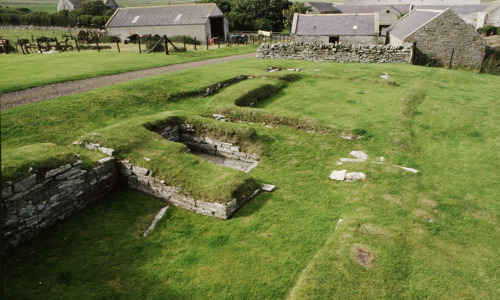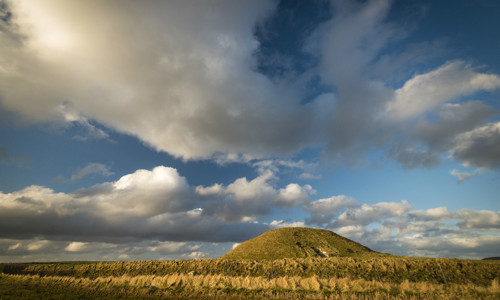History
The long cairn
The long cairn at Camster is a spectacular monument, nearly 60m long and 20m wide. It has been reconstructed in modern times, but was probably originally built in the early 4th millennium.
It has a curved forecourt at each end. The north-eastern forecourt is defined by a low platform and short, stepped horns. Unusually, it does not frame an entrance door.
The cairn has a long history of exploration, and prior to the first excavations in 1865–6 it had a very different profile.
Two burial chambers were found in the cairn. Both had originally formed part of separate round cairns, entered by cramped passages. Later, it seems, they were incorporated into the single long cairn we see today, though nobody is sure why. The development of the cairn and its original appearance are still disputed.
The round cairn
The round cairn is significantly smaller than the long cairn, about 18m in diameter and 4m tall. It’s similar in shape and size to the round cairns that were incorporated into the long cairn, but is unlikely to be of similar age. It has not been subject to the same degree of exploration.
The cairn features:
- a curving forecourt
- a cramped passage
- a surprisingly spacious central burial chamber, separated into three compartments by upright slabs
- corbelled walls supporting the cairn roof
Excavations in the 1800s found burnt human remains, flint tools and pottery. Its passage had been deliberately blocked, and inside two skeletons were found, apparently placed in a sitting position.
Beaten to the punch
The Grey Cairns of Camster have a long history of archaeological investigation. Of the two, the long cairn has been more extensively explored. Before excavation, it had the appearance of a series of humps joined by a spine. Both cairns were excavated in 1865. Human remains were found in both.
A similar cairn in our care at Cnoc Freicedain, 15 miles to the north-west, has not yet been investigated. Archaeological excavation there could shed light on the Grey Cairns of Camster.













